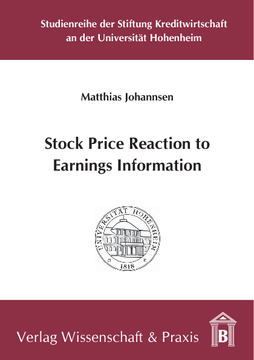Stock Price Reaction to Earnings Information

BOOK
Cite BOOK
Style
Format
Stock Price Reaction to Earnings Information
Studienreihe der Stiftung Kreditwirtschaft an der Universität Hohenheim, Vol. 47
(2010)
Additional Information
Book Details
Pricing
Abstract
This work investigates the reaction of capital market participants to information contained in financial statements of German public limited companies. The application of accounting standards requires discretion which may be exercised to pursue opportunistic incentives or incentives to increase the information content of financial statements. This work explores these issues and is structured in two main parts. Using annual data of 850 firms listed on German stock exchanges for the years 1990 to 2003 it is shown in the first part that stock prices react only gradually to earnings information. This finding supports the post-earnings announcement drift. In the second part it is demonstrated that for cases with incentives for opportunistic earnings management and with high (low) degrees of earnings management, share prices react more (less) gradually to earnings information.
Table of Contents
| Section Title | Page | Action | Price |
|---|---|---|---|
| Table of Contents | 5 | ||
| Tables | 8 | ||
| Figures | 9 | ||
| Appendices | 10 | ||
| Abbreviations and Variables | 11 | ||
| 1. Problem outline | 17 | ||
| 2. Investigation of the post-earnings-announcement drift in Germany | 21 | ||
| 2.1 Introduction | 21 | ||
| 2.2 Current state of academic discussion | 22 | ||
| 2.2.1 The concept of market efficiency | 22 | ||
| 2.2.2 The post-earnings-announcement drift | 22 | ||
| 2.2.2.1 Implications for market efficiency | 22 | ||
| 2.2.2.2 Summary of evidence | 23 | ||
| 2.2.3 Existing explanations for the post-earnings-announcement drift | 26 | ||
| 2.2.4 Commentary on existing explanations | 27 | ||
| 2.3 Research design | 29 | ||
| 2.3.1 Research methodology | 29 | ||
| 2.3.2 Considered variables for a risk-based investigation | 33 | ||
| 2.3.3 Hypotheses development | 36 | ||
| 2.4 Sample construction | 37 | ||
| 2.4.1 Data collection | 37 | ||
| 2.4.2 Variable computation | 37 | ||
| 2.4.2.1 Unexpected earnings | 37 | ||
| 2.4.2.2 Unexpected earnings portfolio formation | 40 | ||
| 2.4.2.3 Risk-related variables | 41 | ||
| 2.4.2.4 Abnormal returns | 43 | ||
| 2.5 Data analysis | 45 | ||
| 2.5.1 Investigation of hypothesis 1 | 45 | ||
| 2.5.1.1 Cumulative abnormal returns of unexpected earnings portfolios | 45 | ||
| 2.5.1.2 Significance tests of the cumulative abnormal returns | 50 | ||
| 2.5.2 Investigation of hypothesis 2 | 58 | ||
| 2.5.3 Investigation of hypothesis 3 | 60 | ||
| 2.5.3.1 Analysis of covariance | 61 | ||
| 2.5.3.2 Sub-samples based on size and book-to-market ratio | 66 | ||
| 2.6 Conclusion | 72 | ||
| 3. Investigation of the capital market reaction to earnings management | 75 | ||
| 3.1 Introduction | 75 | ||
| 3.2 Current state of academic discussion | 76 | ||
| 3.2.1 General concept of earnings management | 76 | ||
| 3.2.2 Incentives of earnings management | 77 | ||
| 3.2.2.1 Types of incentives | 77 | ||
| 3.2.2.2 Incentives of opportunistic earnings management | 78 | ||
| 3.2.2.3 Incentives of informative earnings management | 81 | ||
| 3.2.3 Capital market reaction to earnings management | 82 | ||
| 3.2.3.1 Concealing effect of earnings management | 82 | ||
| 3.2.3.2 Informative effect of earnings management | 83 | ||
| 3.2.4 Summary | 84 | ||
| 3.3 Research design | 84 | ||
| 3.3.1 Theoretical considerations | 84 | ||
| 3.3.2 Hypotheses development | 86 | ||
| 3.3.3 Research methodology | 88 | ||
| 3.4 Sample construction | 90 | ||
| 3.4.1 Data collection | 90 | ||
| 3.4.2 Variable computation | 91 | ||
| 3.4.2.1 Earnings management variables | 91 | ||
| 3.4.2.1.1 Different approaches to measure earnings management | 91 | ||
| 3.4.2.1.2 Comment on the different approaches | 95 | ||
| 3.4.2.1.3 Used measures of earnings management | 98 | ||
| 3.4.2.2 Earnings informativeness variables | 100 | ||
| 3.4.2.3 Control variables | 107 | ||
| 3.4.2.4 Absolute cumulative abnormal returns | 109 | ||
| 3.5 Data analysis | 111 | ||
| 3.5.1 Correlations among key variables | 111 | ||
| 3.5.2 Investigation of hypotheses 1 and 2 | 113 | ||
| 3.5.3 Investigation of hypothesis 3 | 118 | ||
| 3.5.3.1 Hypothesis tests | 118 | ||
| 3.5.3.2 Fixed effects panel regressions | 123 | ||
| 3.6 Conclusion | 134 | ||
| 4. Summary | 137 | ||
| 4.1 Main results | 137 | ||
| 4.2 Implications for market participants | 138 | ||
| 4.3 Implications for accounting standard setters | 139 | ||
| 4.4 Implications for future research | 139 | ||
| References | 141 | ||
| Appendices | 155 |
